Historically, the notion that physicians have divine powers to heal goes
back a long, long way. I don't know if that originally came more from
the wishful thinking of some patients or from some medical
practitioners' opinions of their own grandiosity.
Personally, I don't recall any doctor I've seen in my 62 years that
appeared to be so arrogant as to believe (s)he had all the answers to
my illnesses or injuries or medical questions. I've
usually, but not always, trusted my doctors' judgment about prevention and
treatment but I never assume they know everything. I usually do enough
research on my own to have intelligent questions and a healthy
skepticism if something I'm told doesn't jibe with my own assessment of
the situation.
Methinks some patients want to think their doctors have all
the answers so they
don't have to put any thought or effort into their own prevention (lifestyle) or treatment. I
believe in taking more responsibility and initiative for my health care than that.
Jim's like that, too. This summer he's been very proactive in trying
to figure out what to do about his injured knee and what the long-term
ramifications are, like whether he needs a total knee replacement sooner
rather than later or whether he can ever run again..
Problem is, the treatments he's gotten so far from the doctors he's
consulted haven't been sufficient to alleviate his pain and they don't
have crystal balls to know the answers to all his questions.
We think they've probably tried their best but they appear to be a
bit perplexed by Jim's case, too. Read on to see who told us he's "only a doctor, not God."
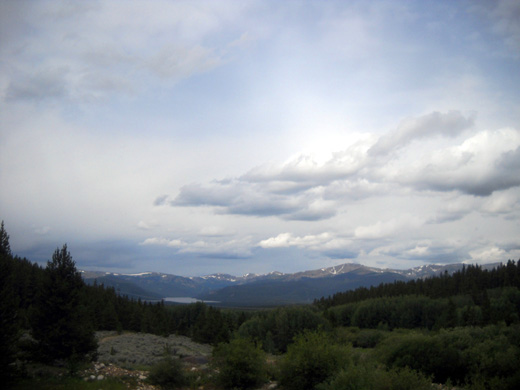
View toward Turquoise Lake from the Mineral Belt
Trail
(Note: the photos in this entry are totally unrelated to the
subject, just added to break up the narrative. They are pictures of
sunrises, sunsets, cloud formations, and storms that I've
taken recently in the Leadville area.)
YET ANOTHER MEDICAL OPINION
I've written several previous entries in 2010 and 2011 about Jim's
knee injury from a bike accident and how that has possibly ended his
running career.
He initially sought treatment, including meniscus surgery, from our
orthopedist in Roanoke, VA, Dr. Johnson. He had surgery last December,
tried to resume training, and
got a steroid shot in March that helped alleviate the pain that wouldn't
go away even when he didn't run.
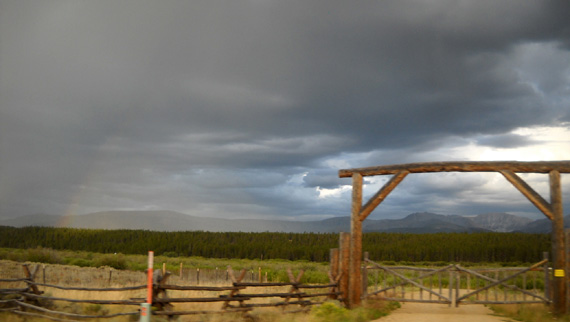
Rainbow on the left
When we were down in the Silverton, CO area earlier this summer the
pain was so persistent that Jim sought the advice of an orthopedic
surgeon in Durango (Dr. Scott). Getting the referral to a qualified
doctor, making sure he was a preferred provider with Jim's health
insurance, and scheduling an appointment as a new patient was tedious
but worth the effort.
A new MRI showed additional
deterioration to the cartilage in his knee from repeated stress
(running, walking) post-surgery. Dr. Scott recommended Jim wear an MCL
brace (medial cruciate ligament) for several weeks and get a series of visco-supplementation
injections similar to the ones I get, but a different brand and
substance.
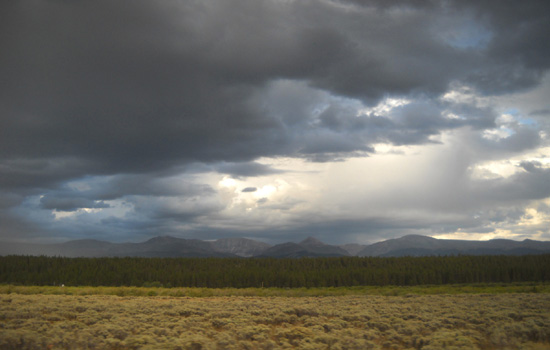
He also warned Jim that he'd need a total knee replacement in one or two years if
he didn't stop running. That was a shock to both of us. I chronicled all that in entries dated
June 22 and
June 30, 2011.
Jim got his last Euflexxa injection on July 11 and crossed his
fingers that his knee would soon start feeling good enough that he could
sleep better at night and be able to at least walk for exercise, if not
eventually return to running.
AFTER ALL THAT -- NO BETTER, NO WORSE
Unfortunately, Jim never got the kind of relief he sought from either
the Euflexxa or the MCL brace.
Although the brace has kept his knee from flexing sideways neither it
nor the injections seem to be alleviating the pain either at night or when when
he walks.
Itís been six weeks since his last injection, and more than that for the
brace, a time period in which he should have seen a difference. His
knee still hurts the same as it did, no better, no worse.
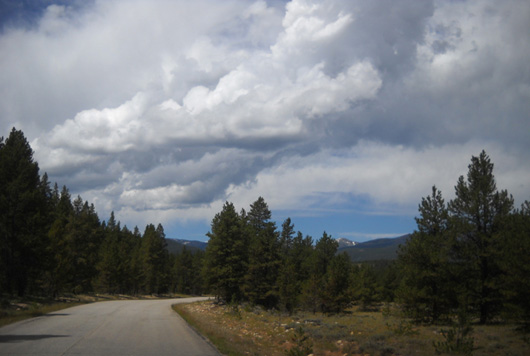
After we got to Leadville Jim talked to a patient rep at Dr. Scott's
office re: getting another steroid shot in his knee. He was
pleased with the temporary results of the steroid he got in March from
Dr. Johnson and he wanted to try that again.
The message he got back from Dr. Scott was that he would give Jim a
steroid injection if his knee still hurt as badly two weeks later when
we planned to leave Colorado and travel even farther away from Durango.
Because of all the hassles of starting over with another doctor
closer to Leadville, Jim was initially willing to drive all the way back
down to Durango in the truck (not with the camper) for the shot --
a distance of about 500 miles round trip! Yikes.
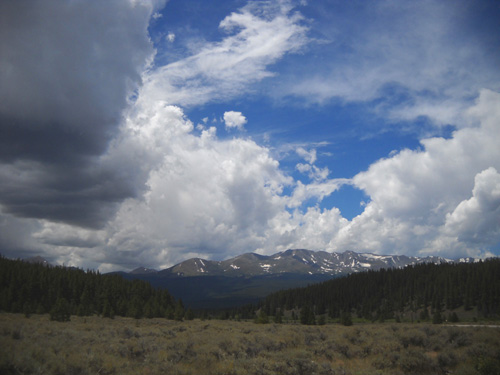
Then he got a bright idea.
While we were working check-in at the LT100 bike race last week we
met the personable Dr. Doug Yeakel, a sports medicine and emergency doctor who is
co-medical director with Dr. John Hall for the Leadville bike race and run. He has
a branch office in Leadville.
How convenient! If Jim could get a steroid shot here, it would save
that very long drive to Durango to see Dr. Scott. Luckily for us,
Dr. Yeakel is a preferred provider with Jim's health insurance plan.
NO MIRACLES LIKELY
Jim was able to
make an appointment for today. Earlier this week he
took in the DVD of the MRI he had in June, Dr. Scottís extensive
medical notes, and a cover letter so hopefully Dr. Yeakel could read the
information and know the whole knee history before Jim went in.
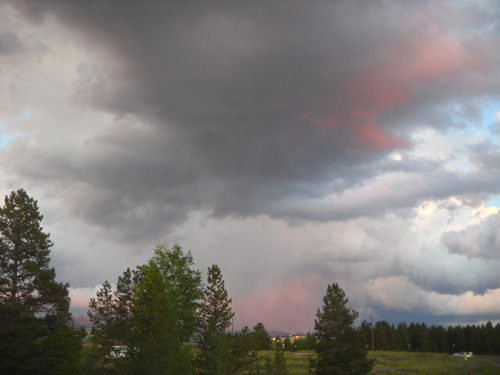
When we arrived at the appointment this afternoon it was obvious Dr. Yeakel
had read through the information. That was a good start.
Early in his conversation with us he made the comment about being "only a doctor, not God"
because of the complexity of Jim's case. He readily
acknowledged he doesn't have all the answers Jim wants to hear, such as
what exactly is causing the knee pain, how to alleviate it, if or how
soon Jim needs a total knee replacement, or if he can ever run again.
As much as he'd
like those answers, what
Jim really wants right now is to be free of pain so he can sleep and
move around more comfortably.
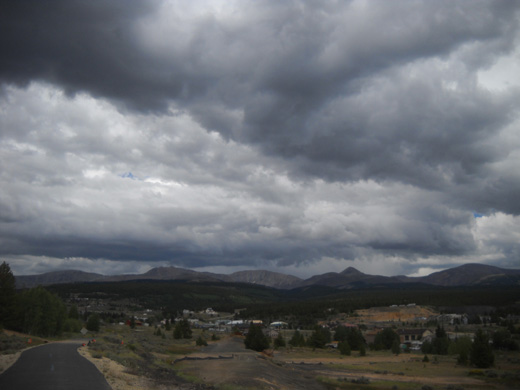
After examining Jimís knee, which
still hurts at a specific spot on the medial side, Dr. Yeakel said he doesnít think
Jim's pain is from an MCL problem Ė nor did the MRI hone in on that.
He thinks very highly of the radiologist who read the MRI from
Durango and will ask him to re-examine the pictures to see if he
initially overlooked
anything that might be wrong with the MCL. Dr. Yeakel will have to get back with
Jim on that, since we're leaving on Monday.
Dr. Yeakel agreed to give Jim another steroid
injection to see if that will relieve his pain like it did (for a couple
months) in March. If it works, the problem isnít the MCL. Dr. Yeakel said
Jim could stop wearing his knee brace now.
He concurs with Dr. Scott
that Jim will probably need a total knee replacement within a few years
but recommends he try visco-supplementation (lubricating injections) at
least one more time before scheduling surgery. He also recommends Jim
focus on cycling and other activities that don't aggravate his knee.

We both liked Dr. Yeakel's "bedside manner." He seems competent and heís got a good
sense of humor to boot, probably because he knew Jim as a volunteer and
athlete first and as a patient second. (If you haven't heard the joke about men having
four "knees," you've missed a groaner!)
Jim has a good sense
of humor, too -- he made a name tag for Dr. Yeakel that reads "God."
He'll give it to him tomorrow at the LT100 run if we see him while we're
working at the Twin Lakes aid station.
Jim left Dr. Yeakel's office with some new optimism that the steroid
injection will reduce his pain at least in the short haul. He's also
happy to get permission to stop wearing the MCL brace.

We also had the chance to talk with Dr. John Hall a couple times this
week. He's the other co-medical director for the Leadville race series and
we've known him for several years.
We were surprised to discover that he got a total
knee replacement this year -- you sure can't tell. It has a rotating platform and is
reportedly better for athletes than standard replacement devices. We'll
do further online research and ask Dr. Johnson about it when we're back
in Roanoke this fall.
A MORE MINOR MEDICAL MATTER
One of the hazards of ultra-distance running is getting black toenails
from repeated foot trauma, primarily jamming the toes into the toe box
of shoes in downhill running.
This section applies to me, not Jim. He hasn't had as many problems
with black toenails as I have.
Both of my big toenails have sustained enough of that sort of trauma
over 30+ years of long-distance running that they have been black for at
least two decades. They used to fall off and grow back but in the past
few years they've just gotten thicker and I can no longer pry them off
after soaking them in water.
Sorry to gross anyone out, but that's a common hazard of being an ultra runner!
At least I never kept the nails and made a necklace out of them
as some runners purportedly have!! (I've seen pictures.)
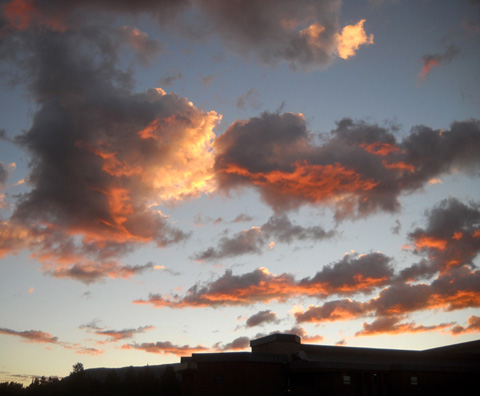
Above and below: sunrise
over the school
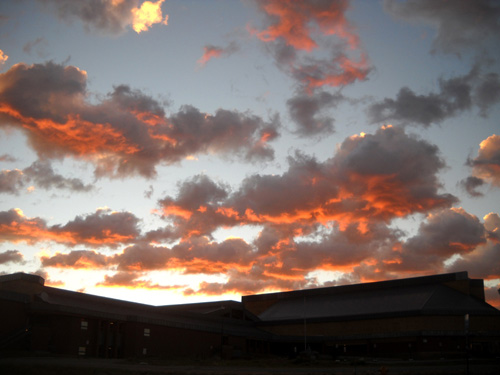
Both of my big toenails are unsightly, but that's never been a big enough reason for
me to have them removed. My dermatologist in Roanoke suggested I may
have a fungal infection under the nails. That hasn't been enough of an
incentive so far either to get them diagnosed, treated, or removed.
Pain is a very good reason, however.
Recently they have begun to hurt, as much in bed with bedcovers on them
(I sleep on my back, toes pointed up) as when I'm hiking.
So I decided to do something about it..
I made an appointment to see
Dr. Callen one day this week. He's a general physician in Leadville who has an office
within sight of our camper at the clinic on 6th Street. He's an amiable fella
I saw two years ago after my bike wreck. I figured he could give
me some advice re: treating the infection, if I have one, or
having the nails surgically removed by someone. I wasn't sure if that
procedure has to be done by a podiatrist or if he could possibly do it.

My appointment was pretty short. Dr. Callen thinks from observation only
that there is no fungus under the two big toenails, but
to be certain I'd have to have them scraped and examined by a lab. If
it's not a fungal infection that can be treated with one of several
drugs, the main options are temporary or permanent removal of the nails. He
indicated the healing process is painful
and takes several weeks or months.
He recommends seeing a podiatrist and getting the nails filed down first to see
if the pain goes away. He said he isn't able to do it properly.
I'll try that on my own until I see a podiatrist in Roanoke this fall.
Either fungal treatment or toenail removal will take several weeks and
we won't be anywhere that long during this trip.
If I end up getting the nails removed, I'll do an entry on the procedure
so other runners will know what to expect -- complete with
pictures! <grin>
Next entry:
volunteering at the LT100 run check-in on Thursday and Friday
Happy trails,
Sue
"Runtrails & Company" - Sue Norwood, Jim O'Neil,
and Cody the Ultra Lab
Previous
Next
© 2011 Sue Norwood and Jim O'Neil












